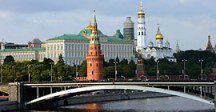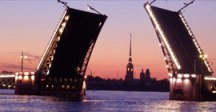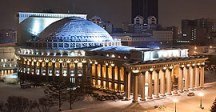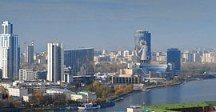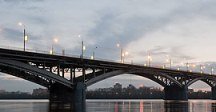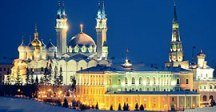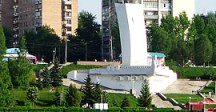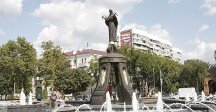Map of Yoshkar-Ola
Detailed interactive map of Yoshkar-Ola. Map of Yoshkar-Ola with streets and numbers of houses. Satellite map of Yoshkar-Ola with sights of the city.
The change between the satellite map of Yoshkar-Ola and the schematic one is made in the lower left corner of the interactive map.
Yoshkar-Ola
Population of Yoshkar-Ola: 276,155 people (2021)
Date of foundation of Yoshkar-Ola: 1584
The telephone code of the city Yoshkar-Ola: +7 8362
The car code of the city Yoshkar-Ola: 12
Postal code of Yoshkar-Ola: 424000-424045
Yoshkar-Ola is a city in Russia, which is the capital of the autonomous subject of the Russian Federation – the Republic of Mari El. The population of the city of Yoshkar-Ola is a little more than 270,000. The modern name of the city was given only at the beginning of the 20th century, and before it was called Tsarevokokshaysk and Krasnokokshaysk. Yoshkar-Ola has two honorary titles: the city of the Labor Banner and the historical city of Russia.
There are many sights in the city, but the main symbol of the autonomous capital is the Tsarevokokshay Kremlin, which was restored only in 2009. Other monuments are the ancient stone Church of the Holy Trinity, the Cathedral of the Resurrection of Christ, the Academic Russian Drama Theater, as well as numerous bronze sculptures.
What to see in Yoshkar-Ola
Pervomaiskaya Street passes through Leninsky Prospekt and just south of Obolensky-Nogotkov Square at the intersection of Pervomaiskaya and Uspenskaya streets, behind the government buildings, there is the Assumption Church. The church is a modern structure built in 2006. It was built in the traditional Byzantine style.
Obolensky-Nogotkov Square is named after Ivan Obolensky-Nogotkov (sometimes spelled Ivan Nogotkov-Obolensky), who was the first governor of Tsarevokokshaysk - as Yoshkar-Ola used to be called. He was appointed in 1584 by Tsar Fyodor. Right next to this monument is a smaller copy of the Moscow Tsar cannon.
The National Art Gallery on Leninsky Prospekt. The beautiful building located on Obolensky-Nogotkov Square, which itself is one of the most picturesque squares in the city, is partially occupied by the National Art Gallery. The gallery has a permanent exhibition, but temporary exhibitions of works from various Russian and foreign museums and private collections are also held. The gallery building is famous for its clock tower.
The Republican Museum of Fine Arts on Gogol Street is located in a specially built building and presents works of art, decorative and applied art, sculpture and graphics by Russian artists, including local Mari artists. The museum has several halls dedicated to the work of the artist Boris Ivanov, whose paintings depict characters with large round faces. Various temporary exhibitions are also held here.
Monument to St. Leonid. Next to the National Art Gallery there is a modern statue of St. Leonid, Bishop of Mari El. Leonid became Bishop of Mari El in 1937. He was canonized in 2002 as a New Martyr and confessor of 20th century Russia.
Timofey Evseev National Museum of the Republic of Mari El on Sovetskaya Street. The main Museum of Local Lore of the Republic of Mari El is named after Timofey Evseev, a Mari ethnographer, folklorist and historian. The museum tells in detail about the history, ethnography and nature of the republic. It also contains information about the traditions, clothing and spiritual life of the Mari people.
The new statue in Yoshkar-Ola, which has become a symbol of the city, represents a cat sitting on a bench. The reason for this unusual monument lies in the Russian euphemism “Yoshkin's cat”, which sounds like "the cat from Yoshkar-Ola". A little further down Gagarin Avenue there is another statue of a cat.
The Annunciation Cathedral is located on the Republic Square of the Blessed Virgin Mary, at the intersection of the Voskresenskaya Embankment and Chavain Boulevard. Just behind the cathedral there is a statue of the Virgin Mary and a fountain.
The embankment on the left bank of the Malaya Kokshaga River is known as the Bruges Embankment in honor of the Belgian city, since all modern buildings here are built in the Flemish style. Since its construction, the embankment has become the hallmark of the city.
At the end of Chavain Boulevard is the central park of Yoshkar-Ola, which is officially known as the Central Park of Culture and Recreation named after the 30th anniversary of the All-Union Lenin Youth Union.
There are several attractions here, as well as statues called the Tree of Life and the Tree of Memory, as well as a monument to Lenin. In the northeast of the park is the Tikhvin Church of the Blessed Virgin Mary, built in 1774. The western side of the park is known as the Square of Military Glory.
The Folk Art Museum is located in an old wooden house. Various examples of decorative and applied art are presented here, especially with an emphasis on Mari art.
The square, located between the Voskresenskaya and Bruges embankments to the north of the Malaya Kokshaga River, is known as Patriarch's Square. In the center of the square there is a statue of Patriarch Alexy II releasing a dove.
The right bank of the Malaya Kokshaga River is known as the Voskresenskaya Embankment, which then becomes the Amsterdam embankment in the south. There are also several monuments on these embankments. To the north, outside the Resurrection Cathedral, there is a statue of Tsar Fyodor, which is said to be the only statue of Ivan the Terrible's son in the world.
At the intersection of Voznesenskaya Street and Tsargradsky Avenue there is a church complex consisting of the Voznesensky Cathedral and some other buildings. The Ascension Cathedral was built in 1756 as a two-story building with an octagon on a cube. The bell tower dates back to 2009, as the original was destroyed during the Soviet period, when the church was closed from 1937 to 1995.
Gulag Museum on Sovetskaya Street. Just behind the Tsarevokokshay Kremlin is the Gulag Museum, which is probably one of the best museums in the country, detailing the system of Soviet forced labor camps. The museum is located in a building that was once the headquarters of the NKVD. The museum has many statues of Stalin, Lenin and other revolutionaries.
The Yoshkar-Ola History Museum was founded in 1996 and is located in a mansion of the early 20th century. It tells in detail about the founding of the city and its development over the centuries, including information about the faith, traditions and daily life of its inhabitants.
The original Resurrection Cathedral was built in 1759 in the decorative style of the Moscow Baroque. The current version is a reconstruction that was built between 2008 and 2009.
Trinity Church was built in 1763 and was actually the first stone building built in the city. The beautiful church consists of a tall structure with five small domes and rows of kokoshniks. Next to the church there is a bell tower built in the same style.
Tsarevokokshaysky Kremlin on Voznesenskaya Street. While most of Russia's other kremlins date back to the 15th, 16th or 17th centuries, the Kremlin in Yoshkar-Ola is a modern reconstruction that was built in 2009 around Revolution Square.
The Kremlin is called the Tsarevokokshaysky Kremlin, since Yoshkar-Ola was previously known as Tsarevokokshaysk. Inside the Kremlin there are several cannons, several stands telling about the history of the city, and some other attractions.
Distance from Yoshkar-Ola to major cities
By road: Petrozavodsk ~ 1434 km., Vologda ~ 866 km., Syktyvkar ~ 724 km., Kirov ~ 297 km., Berezniki ~ 846 km., Glazov ~ 396 km., Nizhny Novgorod ~ 325 km., Vladimir ~ 576 km., Moscow ~ 764 km., Izhevsk ~ 523 km., Perm ~ 669 km., Yekaterinburg ~ 1025 km., Cheboksary ~ 96 km., Saransk ~ 418 km., Ulyanovsk ~ 317 km., Samara ~ 559 km., Kazan ~ 145 km., Orenburg ~ 873 km.
The economy of Yoshkar-Ola
The city has developed mechanical engineering, production of building materials, light and food industries, chemical, forestry and fuel industries, pharmaceutical and printing industries.
The sights of Yoshkar-Ola
Museum of the History of the City and the Republic, Tsarevokokshay Kremlin, Monument to Fyodor Ioanovich, Nogotkov-Obolensky Square, National Art Gallery, Tsar Cannon, Monument to Hieromartyr Leonid, Blagoveshchenskaya Tower of Yoshkar-Ola, Bruges Embankment, Monument to Empress Elizabeth, Yoshkin the Cat and Yoshkin the Cat, Peter and Fevronia, Monument to Patriarch Alexy II, Republican Theater dolls, the Mari Opera and Ballet Theater named after Eric Sapaev, the Mari National Drama Theater named after M. Shketan, the Academic Russian Drama Theater named after Georgy Konstantinov.
The largest cities in Russia:
2024 © Russia-Karta.ru
